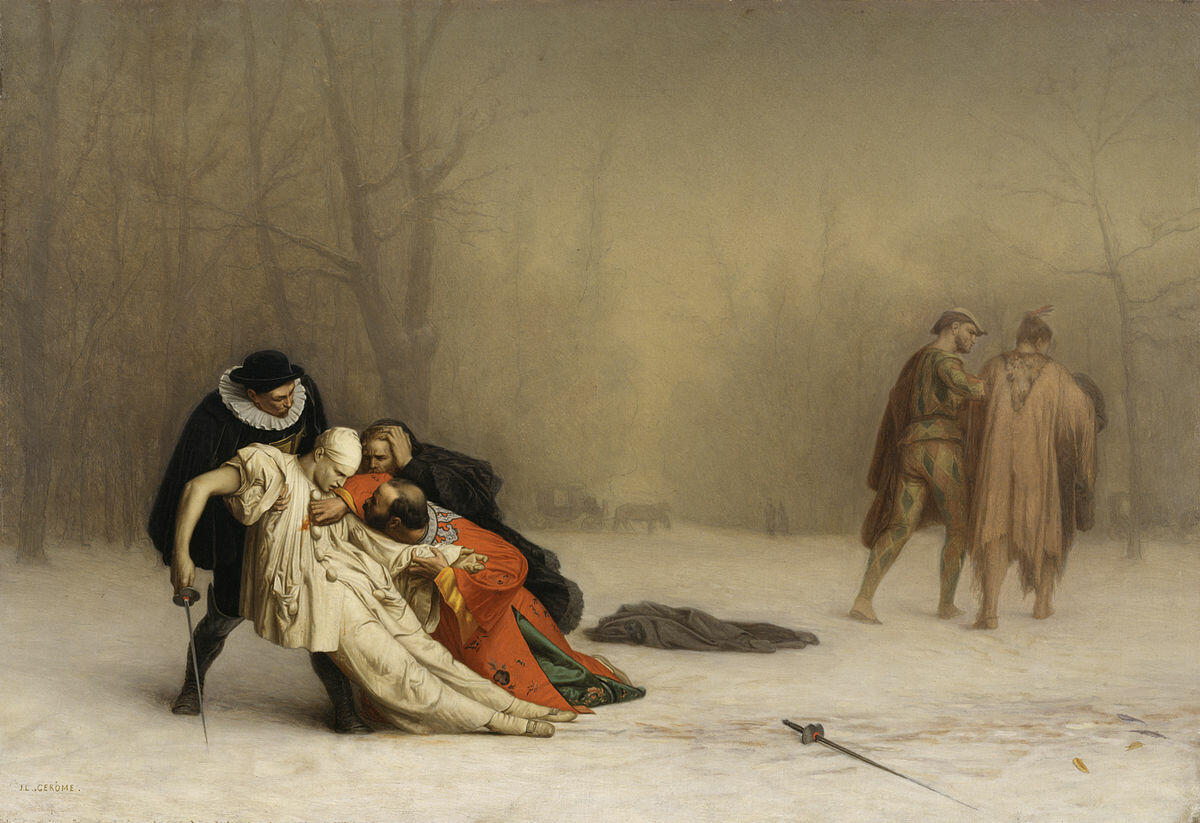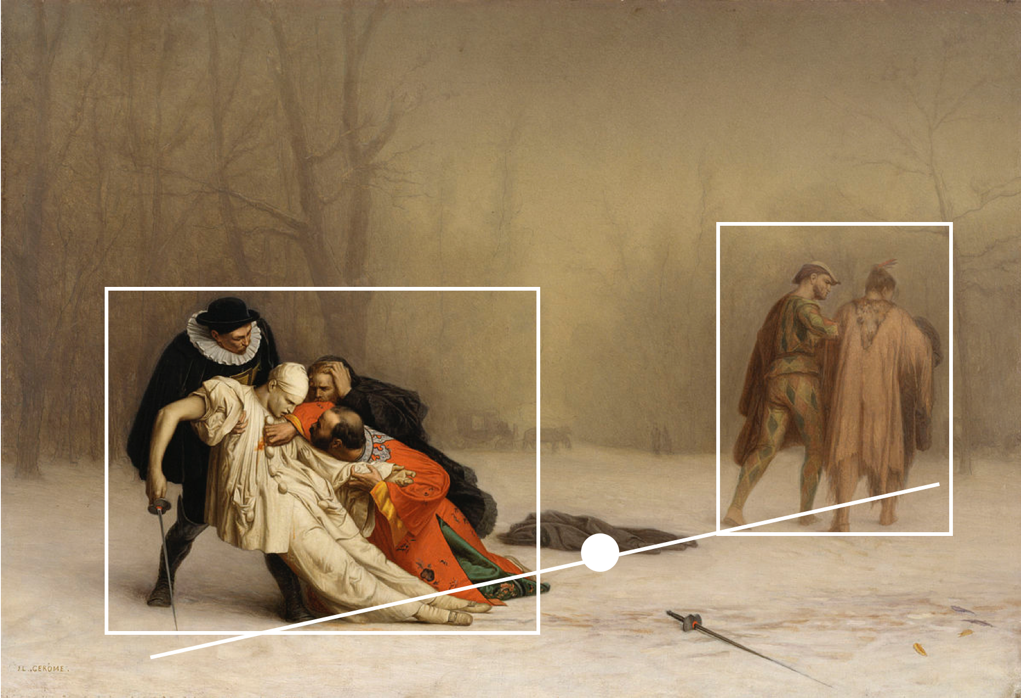The Duel After the Masquerade (oil on canvas, twenty by twenty-eight inches) is a Jean-Léon Gérôme’s painting. It was produced in 1857 and today is located in the Musée Condé in Chantilly, France. Gérôme was a famous painter and sculptor, known for his works in the traditional style of academicism, characterized by such influences as romanticism and neoclassicism. Considered among the most important representatives of the academicism movement, Gérôme’s works included a range of references to Greek mythology, historical events, Orientalism, as well as other subjects.
The artist’s popular works include such paintings as Pollice Verso (1872), Truth Coming Out of Her Well (1896), The Tulip Folly (1882), Leda and the Swan (1895), The Carpet Merchant (1887), and multiple others. His paintings have predominantly depicted scenes from mythology, various themes inherent to the culture of the East, as well as images that alluded to the culture of Greeks and Romans. However, the Duel After the Masquerade (Figure 1) is far more complex in its overall presentation and the effect on the viewer and seems not fitting on the painter’s artistic intentions. Because of this, it will be compelling to analyze the painting further to reveal the artist’s ideas as well as to evaluate the value of the piece within Gérôme’s artistic legacy.

Analysis
Context
The Duel After the Masquerade depicts a scene set on a gloomy winter morning somewhere in a forest, with cold bare trees and snow covering the ground. A man dressed as Pierrot the Clown is collapsing in the arms of three men, seemingly being mortally wounded (Curtis, Gauthier, Gunning, & Yumibe, 2018). A surgeon dressed as the Doge of Venice is trying to stop the blood coming from the wound while another man dressed in a costume similar to that of a priest is in shock and is clutching his head. The duel’s survivor is depicted in the background, dressed as an American Indian and leaving the scene, supported by his friend wearing a Harlequin costume. While the wounded Pierrot is still holding his weapon, his opponent dropped it on the ground in a gesture of honor. The entire scene seems bizarre and complex to understand since all characters involved in it are dressed in masquerade ball costumes, symbolizing that even the brightest moments can turn into tragedies.
It should be mentioned that the scene can bear a political meaning because of several reasons. Usually, duels were agreed on engagements between two rivals and only allowed the use of matched weapons to make the chances of winning equally. In early modern Europe, duels were influenced by the medieval code of honor and were predominantly fought with swords. However, the political undertones of the scene should not be missed. The two dueling men depicted in the painting are from the commedia dell’arte and do not represent real people but rather fictional characters. Both Pierrot and Harlequin are clowns and are celebrated during masquerades, similar to the way politicians create characters of themselves to capture an audience.
The thin line between reality and fiction is what makes the Duel After the Masquerade fascinating. The characters conceal their identities and choose ‘clowning’ over revealing who they were in the face of death, thus losing their self-possession and authenticity. This is the main challenge of the entire painting – getting to understand all the details that the author is showing for making conclusions about the nature of human beings. There is a glaring contradiction in what Gérôme depicts: between the seriousness of death in a cold, gloomy forest and the joy of a masquerade.
Color
When comparing the Duel After the Masquerade with other Gérôme’s works, it is a piece that has a much different color palette. In contrast to the vibrant colors, except the stark red, that the painter normally used in his works, neutral and warm tones dominate. The red color of a man’s jacket stands out strongly in the composition, leading the viewer’s gaze to the figure of another man dressed in the Pierrot the Clown costume and the small red slash on his body. It is evident that Gérôme’ intention behind the use of this particular color palette – the eye is immediately drawn to the drama occurring on the left side of the painting, disregarding the two figures of men walking away from the scene. The group of men to the left is the center of interest in the painting because they have the best light and the brightest colors that complement each other. Importantly, the two men wearing black frame the center of attention by adding to the contrast and giving the figures in white and red sharp edges. The two men walking away are painted in very neutral colors as if disappearing from the picture, which also draws more attention to the other group of men.
Composition
The composition of Gérôme’s piece also deserves attention. It can be classified as steelyard composition, in which a particular distribution of forms based on size is used. Usually, there is a larger and a smaller sized element placed in two opposite directions from the center. Also, there is a point of balance between the two elements. The composition of the painting is reminiscent of a ‘seesaw’ to achieve balance, as illustrated below:

As seen from the schematic interpretation of the painting’s composition, in the Duel After the Masquerade, the larger element is represented by the group of men on the left while the smaller one is the two men to the right. The point of balance is the piece of cloth (someone’s cape or jacket) placed in the center of the composition. The ‘seesaw’ is balanced through the heavier (larger) element is closer to the point of balance and the lighter (smaller) being closer to the frame.
Contrast
When considering the colors of the canvas from the point of view of contrast, it is possible to see how the artist focuses on two scenes. In the foreground where the struck man in Pierrot’s costume is displayed bright hues emphasize the liveliness of the situation and attract the attention of observers. In the background where the winning opponent leaves with his second the colors are dull and dark, which is probably done to reduce the emphasis on the two characters. Although both duelists have just been at a masquerade and have bright costumes, only the loser is depicted as detailed as possible. Winter weather may be the cause of the blurred silhouette of the man in an Indian suit; however, the artist probably made such a contrasting distinction intentionally. Moreover, people bending over Pierrot also look distinct and bright, which proves that Gérôme sought to concentrate the attention of the observer on one plane of the canvas.
Shape
The painting does not carry any features of non-standard work and is the clear and detailed plan of one scene. Character mapping is proportional, which can be seen from the distinction between two separate plans. The lines are smooth and unsharp, which is typical for this style of painting. On the canvas, there are no precise details of the surrounding area since the main focus is on the direct participants. Vague outlines of trees indicate that the action takes place in the forest, but it is the only element that allows observers to navigate in a particular location. The style of Gérôme is traced to convey the dynamics of the scene as accurately as possible through gestures and facial expressions of the characters, which confirms the realism of the painting.
Conclusion
To conclude, the Duel After the Masquerade is a unique painting that does not fit in the usual style of Jean-Léon Gérôme. The smart use of colors in the painting adds to the emotional context of the scene as well as its compositional value. The painter intentionally emphasized the focal point of the scene to underline the drama and tragedy through preserving the traditional approaches to compositional balance. When it comes to the contextual value of the painting, Gérôme shed light on the complex nature of human beings who often conceal their personalities to pursue different goals. The stark contrast between the tragedy of the duel and the gaiety of a masquerade makes the audience wonder about what happened before that duel while the author never revealed the whole story. Viewers are left to speculate and argue about the Duel After the Masquerade. While some can see parallels between clowns and politicians, others see the scene as a tragicomic accident that should have never happened.
References
Curtis, S., Gauthier, P., Gunning, T., & Yumibe, J. (Eds.). (2018). The image in early cinema: Form and material. Bloomington, IN: Indiana University Press.
The Duel After the Masquerade [Image] (n.d.). Web.